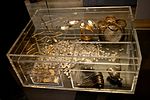Oakley, Suffolk

Oakley is a village and former civil parish in the Mid Suffolk district, in the north of the English county of Suffolk. It lies immediately to the south of the River Waveney around 3 miles (4.8 km) north-east of Eye and the same distance south-east of Diss. The village of Scole is 1 mile (1.6 km) north-east across the River Waveney. In 1961 the parish had a population of 204. The village is in the parish of Brome and Oakley and the benefice has been combined with the village of Brome for centuries but the civil parish was only combined on 1 April 1982.The village church is dedicated to St Nicholas. It is a Grade II* listed building dating from the 14th century.
Excerpt from the Wikipedia article Oakley, Suffolk (License: CC BY-SA 3.0, Authors, Images).Oakley, Suffolk
Lower Oakley, Mid Suffolk Brome and Oakley
Geographical coordinates (GPS) Address Nearby Places Show on map
Geographical coordinates (GPS)
| Latitude | Longitude |
|---|---|
| N 52.358 ° | E 1.176 ° |
Address
Lower Oakley
Lower Oakley
IP21 4AQ Mid Suffolk, Brome and Oakley
England, United Kingdom
Open on Google Maps









